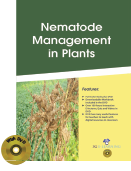Agriculture and Life Sciences

Plant parasitic nematodes are small microscopic roundworms that live in the soil and attack the roots of plants. Crop production problems induced by nematodes, therefore, generally occur as a result of root dysfunction, reducing rooting volume and foraging and utilization e ciency of water and nutrients. Many di erent genera and species of nematodes can be important to crop production. In many cases a mixed community of plant parasitic nematodes is present in a eld, rather than having a single species occurring alone. In general, the most widespread and economically important nematode species include the root-knot nematode, Meloidogyne spp., and sting nematode, Belonolaimus longicaudatus. The host range of these nematodes, as with others, includes many di erent weeds and most if not all of the commercially grown vegetables within the state. Yield reductions can be extensive but vary signi cantly between plant and nematode species.
Nematode problems are more severe and complicated in warmer than cooler areas, in horticultural than eld crops, mono-culture than multi-culture, plantation crops than natural forests and vegetation. Horticultural crops are more e cient producers of biomass and harvestable produce than the agronomical crops.
Nematodes pose a constraint to horticultural development and intensive cultivation. Besides causing quantitative losses, nematodes are known to reduce vitamins and minerals in edible plant parts. Nematode damage is less obvious and many a times goes unnoticed. It causes gradual decline in yield. Nematodes cause complex diseases in association with other soil-borne pathogen.